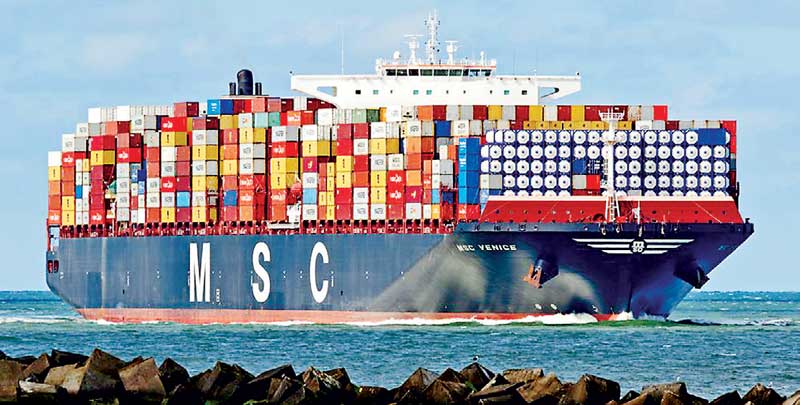Tuesday Mar 04, 2025
Tuesday Mar 04, 2025
Thursday, 26 September 2024 13:42 - - {{hitsCtrl.values.hits}}

MSC Mediterranean Shipping Company SA plans to brave volatile shipping markets on its own, ruling out a new alliance just months before its partnership with A.P. Moller-Maersk A/S ends.
“We want to be standalone,” Chief Executive Officer Soren Toft said in a telephone interview. “We will be in charge of our own destiny, so that we can provide the speed, agility and decision making to our clients that we want.”
Toft’s strategy for Geneva-based MSC, the world’s largest container line, is heavily weighted on intercontinental shipping. By contrast, Maersk is seeking to become a broader logistics company with integrated sea and land operations and unveiled plans in January to team up with Hapag-Lloyd AG to combine parts of their fleets.
MSC and Maersk formed their so-called 2M alliance in 2015 to pool cargo on their vessels. As their strategies diverged, they announced in early 2023 that they would end the partnership early next year.
The goal of vessel-sharing agreements is to maximize capacity and keep costs low at a time of increased instability in global trade. Rising protectionism and geopolitical conflicts stand in contrast with continued growth in shipped volumes.
MSC’s go-it-alone strategy is a reflection of its increased dominance in container trade after overtaking Maersk as the world leader in 2022. Founded by Italian Gianluigi Aponte in 1970, the company has grown to operate 853 ships with a capacity of more than 6 million standard cargo containers, according to data provider Alphaliner.
Its fleet is equivalent to about 20% of global shipping capacity, and the share will likely rise in coming years as the private company has signed almost a third of the world’s ship orders — more than four times as much as Maersk.
Toft dismissed concerns of overcapacity and falling freight rates as probably overblown, pointing to bottlenecks that arose when demand picked up after the end of Covid pandemic lockdowns and the disruptions caused by the closing of the Suez Canal.
Freight rates surged during the post-pandemic consumer boom only to crash in 2023 once supply lines and consumption normalized. As the Red Sea conflict disrupted supply lines late last year, rates jumped again, almost quadrupling over six months.
“If you look at our order book, this is also a signal to our clients that we believe in shipping,” said the 50-year-old executive, who has run MSC since 2020. “We are a shipping company, we are ordering assets that will be in our fleet for the next 25 to 30 years.”
On Monday, MSC announced a new network plan that aims to provide customers with greater flexibility to adapt to global events. The system will have five routes: Asia-Mediterranean, Asia-North America West Coast, Asia-North America East Coast, Asia-North Europe and the transatlantic network. Within those trading lanes their will be loops — 34 in total — to be more nimble.
The new network will “offer clients a lot of direct port pairs” and “a lot of choice,” Toft said. “We believe that this will offer ourselves and our clients the best flexibility that we possibly can.”
MSC’s routes, for instance, will let companies ship through the Suez Canal or opt to go around the Cape of Good Hope if the security situation doesn’t improve. Maersk and Hapag-Lloyd announced a similar option on Tuesday.
For months, Yemen’s Houthi militants have targeted vessels in the Red Sea in protest over Israel’s war with Hamas. That has forced ships to sail around South Africa instead of through the key passage between Europe and Asia Suez Canal, adding thousands of miles to voyages.
“I believe there will not be any short-term solution on the horizon” to guarantee safe passage through the canal, Toft said.
Despite global volatility and ongoing threats to shipping, the MSC boss was cautiously upbeat. “We are not seeing any recession,” he said. “We are seeing a moderately positive outlook for demand.” (Source: Bloomberg)
Discover Kapruka, the leading online shopping platform in Sri Lanka, where you can conveniently send Gifts and Flowers to your loved ones for any event including Valentine ’s Day. Explore a wide range of popular Shopping Categories on Kapruka, including Toys, Groceries, Electronics, Birthday Cakes, Fruits, Chocolates, Flower Bouquets, Clothing, Watches, Lingerie, Gift Sets and Jewellery. Also if you’re interested in selling with Kapruka, Partner Central by Kapruka is the best solution to start with. Moreover, through Kapruka Global Shop, you can also enjoy the convenience of purchasing products from renowned platforms like Amazon and eBay and have them delivered to Sri Lanka.
Discover Kapruka, the leading online shopping platform in Sri Lanka, where you can conveniently send Gifts and Flowers to your loved ones for any event including Valentine ’s Day. Explore a wide range of popular Shopping Categories on Kapruka, including Toys, Groceries, Electronics, Birthday Cakes, Fruits, Chocolates, Flower Bouquets, Clothing, Watches, Lingerie, Gift Sets and Jewellery. Also if you’re interested in selling with Kapruka, Partner Central by Kapruka is the best solution to start with. Moreover, through Kapruka Global Shop, you can also enjoy the convenience of purchasing products from renowned platforms like Amazon and eBay and have them delivered to Sri Lanka.